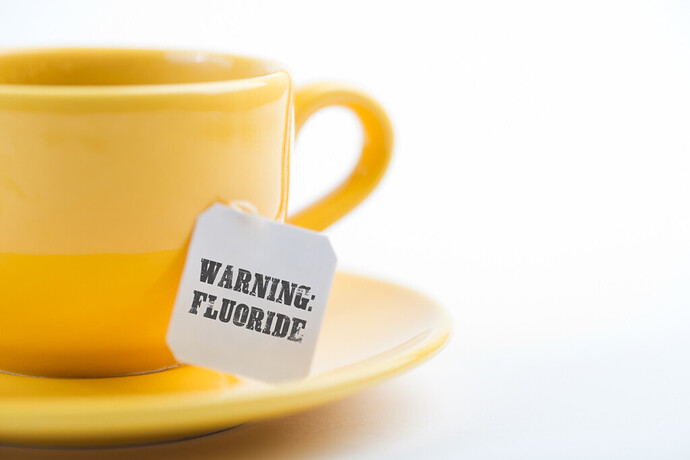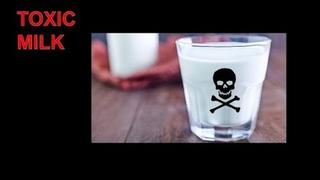Fluoride In Tea: Black, Green, White, Herbal & More (Search 357+ Teas)
December 28, 2023 by Casey J Krol
1.9k
SHARES
Fluoride in tea is one of the most potent and forgotten sources of fluoride.
In fact, some tea has two, three or even six times the amount of fluoride when compared to tap water. Easily putting millions of people around the world over the safe amount of daily fluoride intake.
Table of Contents show
Fluoride In Tea

Teas such as green, black, white, and oolong – are made from the leaves of the Camellia Sinensis plant. Problem is, when the tea plant grows, it absorbs fluoride from the surrounding soil and stores it in its leaves.
However, since each type of tea is processed differently, fluoride levels vary. For example, black tea is made from older leaves while white tea is made from younger leaves. This is why, on average – black tea contains more fluoride than white tea.
In addition to being a large source of fluoride, 94.9% of the fluoride in a cup of tea is directly available for the body to absorb.1 A possibly deadly addition when combined with other sources of fluoride.
Especially when you consider fluoride in food, where high levels of fluoride may be found in foods people eat everyday like vegetables, chicken, nuts, grains, lentils, and legumes.
Health Effects Of Fluoride
Consuming the wrong tea will greatly increase your chances of developing fluoride toxicity.
For example, in recent years there has been a growing number of skeletal fluorosis cases in the USA among heavy tea drinkers.2 A condition that leads to pain and stiffness in a person’s bones and joints3 and awfully resembles arthritis.
However the effects don’t stop there…

In fact, the most popular health effect is pineal gland calcification. Which is when fluoride accumulates in the pineal gland, calcifies it (pictured above), and causes it to become in/underactive -resulting in less melatonin production. This can result in poor sleep and a host of other health effects.
And if you’re spiritual, fluoride is also known to “close” the “third eye” (the pineal gland) which is said to be the gateway to spirituality, seat of the soul, and act as a connection to God.
How Does Fluoride Get Into Tea?
For a long time I thought ALL tea was healthy.
Now I’m sure tea was healthy many years ago, specifically before mass pollution.
For example, before the world’s air and soil was polluted, the tea plant would absorb all the healthy substances in its environment (getting the great reputation it has). But now, with soil and rain/ground water high in fluoride due to pollution, the tea plant unfortunately absorbs dangerously high levels of fluoride and many other toxins.

In addition, since soil quality varies from country to country and even within a country, it’s not as easy as telling you to stay away from tea grown in a specific part of the world.
Cough, Cough, China
Which is why the only true answer to this problem is to test every single tea for fluoride. However, before we get to the test results of 357+ teas, there is one more thing you should know.
Fluoride Content Equals Quality Of Tea
Higher quality teas have lower levels of fluoride.
This is because teas with high levels of fluoride tend to contain low amounts of antioxidants. In fact, the increase in fluoride is proportional to the decrease of amino acids and flavonoids.4
For example, mature tea leaves have the lowest antioxidant levels and since they’ve been soaking up fluoride from the soil the longest, they also have the highest fluoride content. While young tea leaves have the most antioxidants and lowest levels of fluoride.
| Tea Type |
Age of Leaves |
Fluoride Content |
Notes |
| Black |
mature |
high |
oxidized after harvest for unique flavors |
| Green |
mature |
high |
not oxidized, preserves healthy substances like flavonoids, catechins and polyphenols |
| Oolong |
mature |
high/ medium |
oxidized half way between green and black tea |
| White |
young + buds |
medium/ low |
more antioxidants than green, black or oolong teas |
| Herbal |
not made from tea leaves |
low/ none |
made from dried fruit, flowers, roots, spices, and herbs |
So overall, looking at how much fluoride a tea contains can be used as a good indicator of its quality – the more fluoride, the less antioxidants, and thus the lower the quality.
Tips On Using The Fluoride Tea Table
To help you navigate through the 357+ teas found in the fluoride-tea table, here are 5 very useful and important tips…
1) Use The Search Bar…
Use the search bar to look up a specific brand or flavor of tea.

2) Sort Fluoride Content In Tea From High or Low
By clicking on “Fluoride (ppm)” once, you’ll sort the fluoride content in tea from low to high. While if you click on it two times, the ranking of fluoride content will show from high to low.

3) Sort Teas By “Type”…
Clicking on “Type” will allow you to search through fluoride in tea based on the type of tea. Which includes: black, green, herbal, oolong, pu-erh, rooibos, and white tea.

4) Sort Through Teas That Are Approved…
By clicking on “Approved?” and then selecting ‘YES”, you’ll be able to see which teas are approved by Truth About Fluoride. Being approved means the tea is safe in regards to fluoride and does not contain any other dangerous ingredients (more on this later).

5) Combine ALL The Tips Together…
For example, let’s say you’re looking for a new herbal tea that is approved and low in fluoride.
To do this, first click on type and select “Herbal“, then click on “Fluoride (ppm)” once to sort from low to high and lastly, click on approved and select “YES“.

Now let’s get to the table…
Fluoride In Tea Table (Search 357+ Teas)
This table is continuously updated.
So if you do not find the brand you’re looking for, reach out to me and I’ll try my best to get it tested for you. But most importantly, share this article with your friends and family by using the blue sharing buttons found at the start or end of the article.
Considering how much fluoride is in tea, you might save or improve someone’s life.
Approved?
Search
Brand Flavor Type Fluoride (p.p.m) Approved?
- «
- ‹
- ...
- 1
- 2
- 3
- 4
- 5
- ...
- ›
- »
Ahmad Tea Apple Refresh Black 2.4 NO
Ahmad Tea Darjeeling Tea Black 0.8 NO
Ahmad Tea Earl Grey Black 1.8 NO
Ahmad Tea English Breakfast Black 1.7 NO
Ahmad Tea English Tea No. 1 Black 1.9 NO
Ahmad Tea Green Tea Pure Green 1.1 NO
Ahmad Tea Jasmine Romance Green 1.1 NO
Ahmad Tea Lemon & Lime Twist Black 2.4 NO
Ahmad Tea Lemon Vitality Green 1.2 NO
Ahmad Tea Mint Mystique Green 1.1 NO
Each tea was steeped for 5 min with 245 ml of filtered water*
6 Things To Know About Fluoride In Tea

1. Steeping Tea For Too Long?
After testing 357+ teas, I was curious to see what would happen to fluoride content if tea was steeped for an extra 5 minutes (10 minutes total).
So I tested 100 teas again.
After steeping teas for 10 minutes, fluoride content increased by an average of 12%. However this varied from tea to tea, with the highest increase reported at 60% and the lowest at 0%. So yes, it’s true that the more you steep your tea, the more fluoride goes into your water. However, if you decide to steep your tea for less, you’ll also get less healthy substances.
A problem with a simple solution…
Get a quality and safe tea that you can steep for as long as you want. This will give you great peace of mind, as the 30 herbal teas that were steeped for 10 minutes remained at 0.0 ppm.
2. Type Of Tea Matters A Lot
After testing 357+ teas it’s safe to say…
Not all teas are equal.
For example, if you take a look at the average amount of fluoride found in various types of teas. You’ll see that black tea ranks with the highest levels, while herbal tea is essentially fluoride-free.

So if you want to play it safe and smart, I’d stick to the types of teas that are known to accumulate low levels of fluoride and toxins in general. Also keep in mind, just because the average fluoride levels in black tea is 1.8 ppm. It’s common many brands are well above that, reaching double or even triple the amount…
3. Does Organic Tea Have Fluoride?
You may be thinking, if a tea is organic it might not contain a toxic substance like fluoride.
But the truth is, it does not matter…

In fact, when it comes to green tea. On average, organic tea would actually contain more fluoride than non-organic green tea. And to my surprise, out of all the green teas I tested – the one that contained the most fluoride was organic.
So I’m not saying don’t buy organic. On average, organic products will contain less toxins. But when it comes to fluoride, it’s not a factor.
4. Teas With The Highest Fluoride Levels
If you take a look at all 357+ teas tested for fluoride, the clear winner with the highest levels of fluoride was black tea. Out of the top 15 teas, 14 of them were black tea with the other one being green.

So if you’re trying to avoid the toxin we know as fluoride, black tea should be a strong pass.
5. There’s More You Should Worry About Than Fluoride
Fluoride is bad enough.
But it does not stop there…
Let’s put it this way, if a tea contains fluoride, what else do you think the tea plant could have absorbed from the polluted soil? Pesticides, lead, or maybe a sprinkle of arsenic?
Point is, if we find fluoride in tea, as we’ve seen today. It’s not unreasonable to assume high levels of other contaminants is a possibility. Making it more important to choose a tea that does not absorb toxins from the soil.
So it’s best if you go with a herbal tea.
Bonus Tip: Avoid Microplastics in Tea
I kid you not but tea bags can put billions of microplastics inside 1 cup of tea. This is because many tea bags are made from nylon or other types of plastic. And when mixed in with hot water, the heat causes the material to leach into your water. So I would avoid all tea bags, use loose leaf tea and get a product like in the photo below.

For the purple bottle on the left, you open the bottom, put in your the loose tea leaves inside the stainless steel (safe ingredient) holder, then pour hot water inside. While the mesh in the middle is the same thing but can be used for a normal cup. That’s how you eliminate any microplastic exposure when drinking tea.
Continues.

































